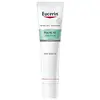Eucerin Pro Acne Solution SOS Serum Versus Nivea Cellular Luminous630 Anti Dark-Spot Post-Acne Marks Serum
What's inside
What's inside
 Key Ingredients
Key Ingredients

 Benefits
Benefits

 Concerns
Concerns

 Ingredients Side-by-side
Ingredients Side-by-side

Water
Skin ConditioningCaprylic/Capric Triglyceride
MaskingMethylpropanediol
SolventButylene Glycol
HumectantPanthenol
Skin ConditioningLactic Acid
BufferingCetearyl Alcohol
EmollientGluconolactone
Skin ConditioningGlyceryl Stearate Se
EmulsifyingCarnitine
CleansingSalicylic Acid
MaskingOctyldodecanol
EmollientPentaerythrityl Tetraisostearate
EmollientPentylene Glycol
Skin ConditioningSodium Hydroxide
BufferingHydroxypropyl Starch Phosphate
Dimethicone
EmollientStearic Acid
CleansingDecylene Glycol
Skin ConditioningXanthan Gum
EmulsifyingHydroxyacetophenone
AntioxidantSodium Stearoyl Glutamate
CleansingSclerotium Gum
Emulsion StabilisingGlycyrrhiza Inflata Root Extract
Skin ConditioningTrisodium Ethylenediamine Disuccinate
Citric Acid
BufferingWater, Caprylic/Capric Triglyceride, Methylpropanediol, Butylene Glycol, Panthenol, Lactic Acid, Cetearyl Alcohol, Gluconolactone, Glyceryl Stearate Se, Carnitine, Salicylic Acid, Octyldodecanol, Pentaerythrityl Tetraisostearate, Pentylene Glycol, Sodium Hydroxide, Hydroxypropyl Starch Phosphate, Dimethicone, Stearic Acid, Decylene Glycol, Xanthan Gum, Hydroxyacetophenone, Sodium Stearoyl Glutamate, Sclerotium Gum, Glycyrrhiza Inflata Root Extract, Trisodium Ethylenediamine Disuccinate, Citric Acid
Water
Skin ConditioningAlcohol Denat.
AntimicrobialGlycerin
HumectantTapioca Starch
Salicylic Acid
MaskingCarbomer
Emulsion StabilisingIsobutylamido Thiazolyl Resorcinol
BleachingSodium Hyaluronate
HumectantCamellia Sinensis Leaf Extract
AntimicrobialPanthenol
Skin ConditioningPantolactone
HumectantIsoquercitrin
AntioxidantGlucosylrutin
AntioxidantGlycyrrhiza Inflata Root Extract
Skin ConditioningAmmonium Acryloyldimethyltaurate/Vp Copolymer
Decylene Glycol
Skin ConditioningCitric Acid
BufferingTrisodium EDTA
Sodium Chloride
MaskingSodium Sulfate
Sodium Hydroxide
BufferingSodium Benzoate
MaskingParfum
MaskingCI 42090
Cosmetic ColorantCI 16035
Cosmetic ColorantWater, Alcohol Denat., Glycerin, Tapioca Starch, Salicylic Acid, Carbomer, Isobutylamido Thiazolyl Resorcinol, Sodium Hyaluronate, Camellia Sinensis Leaf Extract, Panthenol, Pantolactone, Isoquercitrin, Glucosylrutin, Glycyrrhiza Inflata Root Extract, Ammonium Acryloyldimethyltaurate/Vp Copolymer, Decylene Glycol, Citric Acid, Trisodium EDTA, Sodium Chloride, Sodium Sulfate, Sodium Hydroxide, Sodium Benzoate, Parfum, CI 42090, CI 16035
 Reviews
Reviews

Ingredients Explained
These ingredients are found in both products.
Ingredients higher up in an ingredient list are typically present in a larger amount.
Citric Acid is an alpha hydroxy acid (AHA) naturally found in citrus fruits like oranges, lemons, and limes.
Like other AHAs, citric acid can exfoliate skin by breaking down the bonds that hold dead skin cells together. This helps reveal smoother and brighter skin underneath.
However, this exfoliating effect only happens at high concentrations (20%) which can be hard to find in cosmetic products.
Due to this, citric acid is usually included in small amounts as a pH adjuster. This helps keep products slightly more acidic and compatible with skin's natural pH.
In skincare formulas, citric acid can:
While it can provide some skin benefits, research shows lactic acid and glycolic acid are generally more effective and less irritating exfoliants.
Most citric acid used in skincare today is made by fermenting sugars (usually from molasses). This synthetic version is identical to the natural citrus form but easier to stabilize and use in formulations.
Read more about some other popular AHA's here:
Learn more about Citric AcidWe don't have a description for Decylene Glycol yet.
We don't have a description for Glycyrrhiza Inflata Root Extract yet.
Panthenol is a common ingredient that helps hydrate and soothe the skin. It is found naturally in our skin and hair.
There are two forms of panthenol: D and L.
D-panthenol is also known as dexpanthenol. Most cosmetics use dexpanthenol or a mixture of D and L-panthenol.
Panthenol is famous due to its ability to go deeper into the skin's layers. Using this ingredient has numerous pros (and no cons):
Like hyaluronic acid, panthenol is a humectant. Humectants are able to bind and hold large amounts of water to keep skin hydrated.
This ingredient works well for wound healing. It works by increasing tissue in the wound and helps close open wounds.
Once oxidized, panthenol converts to pantothenic acid. Panthothenic acid is found in all living cells.
This ingredient is also referred to as pro-vitamin B5.
Learn more about PanthenolSalicylic Acid (also known as beta hydroxy acid or BHA) is a well-known ingredient for treating skin that struggles with acne and clogged pores. It exfoliates both the skin's surface and deep within the pores to help clear out buildup, control oil, and reduce inflammation.
Unlike AHAs (alpha hydroxy acids), salicylic acid is oil-soluble. This allows it to penetrate into pores which makes it especially effective for treating blackheads and preventing future breakouts.
Salicylic acid is also known for its soothing properties. It has a similar structure to aspirin and can calm inflamed or irritated skin, making it a good option for acne-prone skin that is also sensitive.
Concentrations of 0.5-2% are recognized by the U.S. FDA as an over-the-counter topical acne product.
It can cause irritation and/or dryness if one's skin already has a compromised moisture barrier, so it's best to focus on repairing that before introducing this ingredient into your routine.
While salicylic acid does not increase sun sensitivity, it’s still important to wear sunscreen daily to protect your skin.
If you are looking for the ingredient called BHA or Butylated Hydroxyanisole, click here.
Learn more about Salicylic AcidSodium Hydroxide is also known as lye or caustic soda. It is used to adjust the pH of products; many ingredients require a specific pH to be effective.
In small amounts, sodium hydroxide is considered safe to use. However, large amounts may cause chemical burns due to its high alkaline.
Your skin has a natural pH and acid mantle. This acid mantle helps prevent harmful bacteria from breaking through. The acid mantle also helps keep your skin hydrated.
"Alkaline" refers to a high pH level. A low pH level would be considered acidic.
Learn more about Sodium HydroxideWater. It's the most common cosmetic ingredient of all. You'll usually see it at the top of ingredient lists, meaning that it makes up the largest part of the product.
So why is it so popular? Water most often acts as a solvent - this means that it helps dissolve other ingredients into the formulation.
You'll also recognize water as that liquid we all need to stay alive. If you see this, drink a glass of water. Stay hydrated!
Learn more about Water